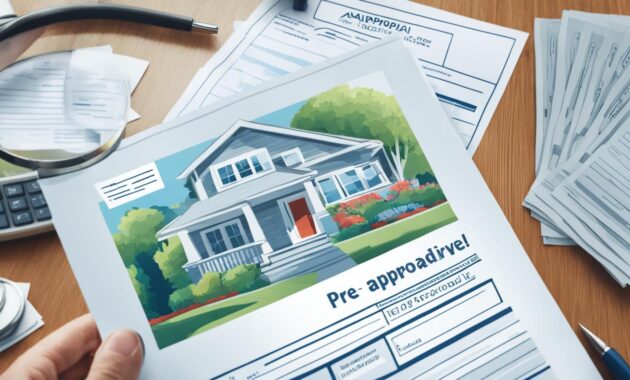Securing a mortgage pre-approval is a crucial first step in the home-buying journey. This comprehensive guide will provide you with expert insights and a step-by-step process to navigate the pre-approval procedure effectively. By understanding the benefits, requirements, and best practices, you’ll be empowered to unlock your dream home with confidence.
Key Takeaways
- Mortgage pre-approval is a critical first step in the home-buying process.
- A pre-approval letter demonstrates to sellers that you’re a serious and qualified buyer.
- The pre-approval process involves evaluating your financial qualifications, including credit score, income, and assets.
- Understanding the pre-approval requirements can help you prepare and increase your chances of approval.
- Choosing the right lender for your pre-approval can make a significant difference in the process and outcome.
Understanding Mortgage Pre-Approval
Mortgage pre-approval is a crucial step in the home-buying process, where a lender evaluates your financial qualifications to determine the maximum loan amount you’re eligible for. This pre-approval letter demonstrates to sellers that you’re a serious and qualified buyer, which can give you an advantage in a competitive housing market.
What is Mortgage Pre-Approval?
Mortgage pre-approval is the process of a lender assessing your credit score, income, and assets to determine the maximum loan amount you can qualify for. This pre-approval letter serves as a powerful tool, signaling to sellers that you have the necessary financing in place and are ready to make a competitive offer on a home.
Benefits of Pre-Approval
Securing a mortgage pre-approval offers several benefits for home buyers. It provides you with a clear understanding of your borrowing capacity, allowing you to search for homes within your budget. Additionally, a pre-approval letter can make your offer more appealing to sellers, as it demonstrates your financial readiness and commitment to the transaction.
Pre-Approval vs. Pre-Qualification
While mortgage pre-approval and pre-qualification may sound similar, they are distinct processes. Pre-qualification is a preliminary assessment based on self-reported financial information, while pre-approval involves a more comprehensive review of your credit, income, and assets. A pre-approval letter holds more weight with sellers, as it indicates a deeper level of financial scrutiny and commitment from the lender.
The Mortgage Pre-Approval Process
Navigating the pre-approval process is a crucial first step in your home-buying journey. By understanding the required pre-approval documents and submitting a comprehensive application, you’ll be well on your way to securing the financing needed to make your dream home a reality. Let’s explore the key steps involved in this process:
Gathering Required Documents
To begin the pre-approval process, you’ll need to gather a variety of financial documents, including recent pay stubs, tax returns, bank statements, and information about your current debts and assets. These pre-approval documents will provide your lender with a clear picture of your financial standing and your ability to make timely mortgage payments.
Submitting Your Application
Once you’ve assembled the necessary pre-approval documents, you’ll be ready to submit your mortgage pre-approval application. Your lender will review your information and evaluate factors such as your pre-approval credit score, income, and debt-to-income ratio to determine the maximum loan amount you qualify for.
Reviewing Your Credit Score
During the pre-approval process, your lender will also review your pre-approval credit score to assess your creditworthiness. This score, which is based on your credit history and payment patterns, plays a significant role in the pre-approval decision and the interest rate you’ll be offered. By understanding your pre-approval credit score in advance, you can take steps to improve it if necessary.

Factors Affecting Mortgage Pre-Approval
The mortgage pre-approval process considers several key factors that can influence the amount you’re eligible to borrow. Understanding these elements can help you better prepare and increase your chances of securing the desired loan amount.
Income and Employment History
Lenders will thoroughly review your income documentation, including pay stubs, W-2 forms, and tax returns, to assess your ability to make monthly mortgage payments. Factors such as your job stability, income sources, and any employment gaps can all impact the mortgage pre-approval requirements.
Debt-to-Income Ratio
Your debt-to-income ratio, which compares your monthly debt payments to your gross monthly income, is a critical factor in the pre-approval process. Lenders want to ensure that your existing debt obligations, including credit card balances, student loans, and other loans, don’t exceed a certain percentage of your income, typically around 43%.
Credit Score and Credit History
Your credit score and credit history play a significant role in the mortgage pre-approval process. Lenders will review your credit report to assess your creditworthiness, payment patterns, and any outstanding debts or delinquencies. Maintaining a strong credit profile can help you secure a more favorable loan offer and interest rate.
Mortgage Pre-Approval Checklist
Preparing for the mortgage pre-approval process is crucial to ensure a smooth and successful journey towards homeownership. Use this comprehensive pre-approval checklist to stay organized and on track:
- Gather all required pre-approval documents, including pay stubs, W-2 forms, tax returns, and bank statements.
- Review your credit score and report, and address any potential issues to optimize your credit profile.
- Calculate your debt-to-income ratio to ensure you meet the lender’s requirements.
- Determine your desired loan amount and monthly mortgage payment based on your budget and financial goals.
- Compare pre-approval offers from multiple lenders to find the best rates, fees, and terms.
- Obtain a pre-approval letter that demonstrates your mortgage pre-approval status to sellers.
By following this mortgage pre-approval checklist, you’ll be well-prepared to navigate the pre-approval requirements and take the first step towards securing your dream home.
Choosing the Right Lender for Pre-Approval
When selecting a lender for your mortgage pre-approval, it’s crucial to consider their reputation, experience, and the competitiveness of their rates and fees. This will ensure you secure the best possible financing to achieve your homeownership goals.
Reputation and Experience
Research the mortgage lender’s track record and reputation in the industry. Look for lenders with a proven history of providing exceptional customer service, efficient processing, and successful pre-approval outcomes. Experienced lenders who understand the nuances of the local real estate market can provide invaluable guidance throughout the process.
Competitive Rates and Fees
Compare mortgage rates and associated fees from multiple pre-approval lenders to find the most advantageous options. A lower interest rate can translate to substantial savings over the life of your loan, while reasonable fees can help you maintain a manageable budget. Carefully review the lender’s pricing structure to ensure you’re getting the best value for your investment.







